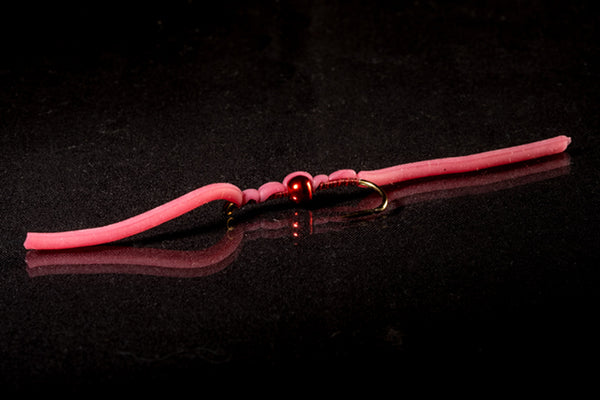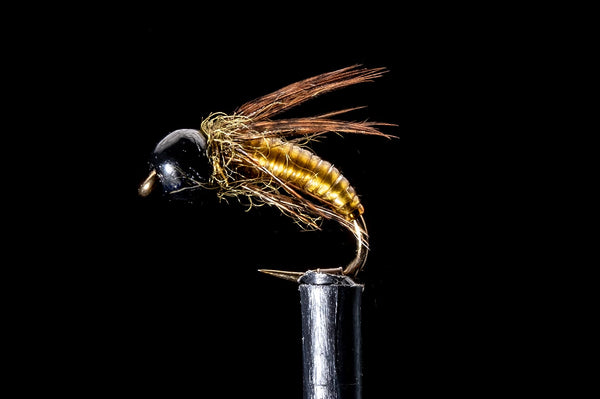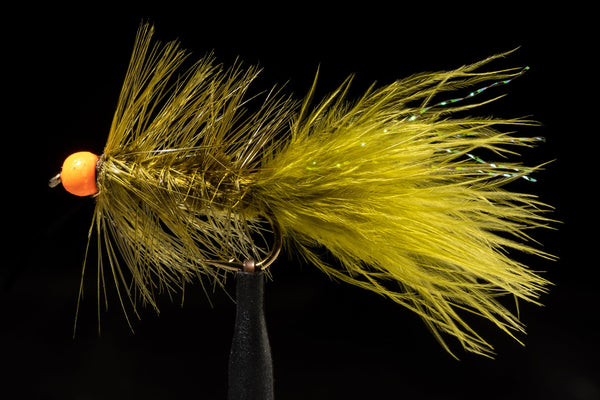What Trout Flies Do I need?
Beginner fly selection – a guide to what you need ...and what you don’t!
One of the trickiest parts of learning how to fly fish is working out which flies to choose. Ollie Basset is a wealth of knowledge at the expert level, but as he largely taught himself how to catch fish, he picked up a huge amount of information to help those of you just starting out. Have a read of his tips and start filling your first fly box.
I pretty vividly remember throwing a bit of a tantrum after losing my entire collection (of about 10) flies in an afternoon on the Ngongotaha River when I first started fly fishing. I’ve subsequently have become much better at getting my flies out of trees and have a few more than ten flies now. Despite a few years down the track, I still remember the confusion I felt when I first started fly fishing and having to buy flies. In this article I hope to clear up the differences between the different types of flies used for river fishing and when to use them. I’ll also cover some of my favourite styles of flies at different times of the year to help you build an effective box of flies without over complicating things (too much).
There's a bunch of topics to cover, it's not just a case of asking the old dude at the local tackle to pick you a winner, and remember that there's a lot of good looking flies out there that are designed to catch fisherman and women, not fish!
Here are the topics I'll cover in my article.
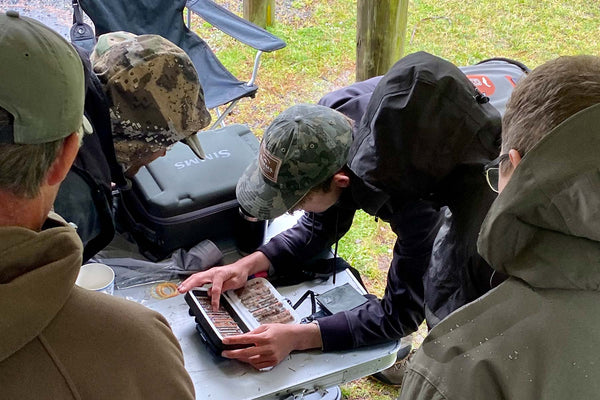
The author critiquing a punter's fly box - photo O.Bassett
Hook Sizes
Let's start by looking at how the different sizes of flies are labelled. This is usually done by hook size, which can be a rather counter intuitive system given that the bigger the number is the smaller the hook. Usually, in New Zealand and Australia, nymphs and dry flies to be fished in rivers will be in size 10 (big) through to size 20 (small).
Nymphs
When it comes to nymphs trout usually don’t key in on a specific insect and so the exact pattern becomes far less important than the presentation. I’m a big believer in having a limited range of nymph patterns in your fly box but in a large variety of weights to match different situations.
Pheasant tails are one of my go to flies as they are small and dark and so do a great job of imitating what most of the trout food in rivers looks like. Chris Dore’s depth control nymph is a good choice here as you can have the same fly in a variety of weights to change around.
The Classic Hare and Copper from the Manic Fly Collection
The other pattern I have a lot of confidence in is some form of the classic hare and copper nymph, again in a variety of weights. Tungsten beads are a great way to add weight to a fly and can be incorporated into nymphs in a variety of sizes for different depths. Typically, I use nymphs in sizes 12-18, and in tungsten bead diameters 2 - 4mm, though some unweighted or also heavily weighted ‘bomb’ type nymphs can be usually too. Try a few patterns and find one you are confident in, then try to build out a selection of different weights and sizes of that pattern rather than buying lots of nymph patterns at random which can make it hard to decide what to use.
Squirmy Worm Red - from the Manic Fly Collection
Sometimes fish, especially in high water or during the winter runs, will eat ‘junk’ flies like worms and eggs. Having some of these flies in your box to try on a hard day is a really good idea as they can be very effective in the right situations.
Dry Flies
The next style of fly are dry flies which float on the surface, imitating either the terrestrial stage of nymphs that have hatched such as adult mayflies and caddis, or ones that have inadvertently fallen into the water like cicadas. The best time to fish these sorts of flies is when trout are rising and eating them off the surface, but it’s possible to try them when fish are not actively rising too. Flies imitating these surface insects are pretty complex sometimes, but I’ll try and break it down as best I can. It's pretty complex, but it's really good to understand the life cycle of trout food so you can present the right meal to them at the right time. You wouldn't be looking for ice cream for breakfast, right? Well, not usually!
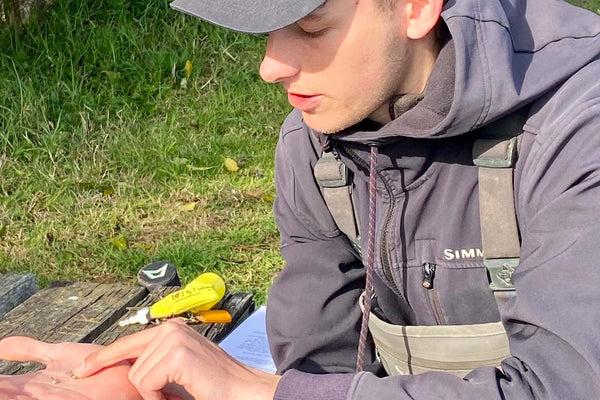
"The one on the left is good...but the one on the right is even better"
When the nymphs on the bottom of the river get to a certain stage they rise to the surface of the water and hatch. Next they dry their wings and float down the river before flying off. After breeding and flying around at night the insects die and float down the river again. It’s often more complicated and varies between different species, but this is the general sort of pattern to be aware of. Usually, the best time to fish dry flies that imitate this life cycle is in the evening when the nymphs are moving to the surface and hatching, but a hatch can also occur at different times of the day depending on the conditions - so be sure to keep an eye out for it.
Often a different style of fly is needed at different stages of the hatch cycle. When nymphs come to the surface and begin to hatch they sit low in the surface film where they are very vulnerable to trout. Trout usually eat these just in or below the surface film which often looks like small dimples in the river. This is the time to use an emergent style dry fly which sits low in the surface and matches they natural insects.
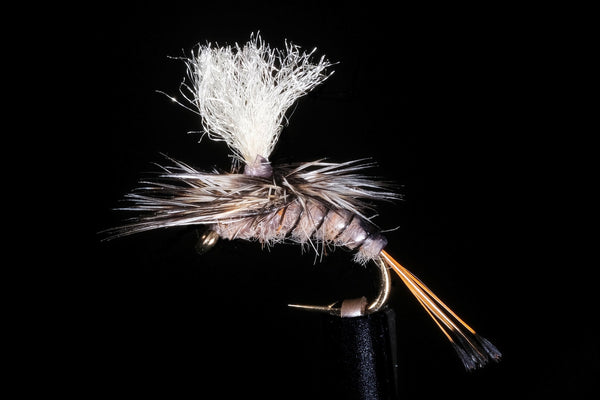
Kyle's Nesameletus Emerger from the Manic Fly Collection
Once the nymphs have hatched and start to float down the river, and as adults dry their wings, trout behavior will change again as they take more quickly to make sure the adult insect doesn’t fly off. These rises will be more splashy and aggressive at this point and it’s time to fish a fly that floats on the surface. Finally, when the flies die and drift down on the river as ‘spinners’ the trout will take more slowly, usually with their heads coming out of the water to confidently take the dead insects which they know can’t escape. This might seem quite complicated and knowing when to use which fly type can be a bit overwhelming, but by watching the way the trout are rising you can usually gather some information on what they are feeding on.
Knowing which fly pattern to fish during these hatches depends upon what sort of insects are hatching. More often, it will be mayflies or caddis. Mayflies are imitated well by small parachute adams type patterns, with the size and shade depending on what you can see on the water. Having some small mayfly emergers such as a klinkhammer style patterns which sit deeper in the surface film is a good idea too, as is having some spinner style patterns for the end of the hatch. Caddis are a small moth like insect which are imitated well by a deer hair caddis type pattern.
Clearwater Caddis from the Manic Fly Collection
Local knowledge is really valuable when it comes to picking these sorts of flies and can save a lot of guess work on the water, so there's always some merit talking to someone in a local fishing shop is a great idea to work out the correct sizes to fish. As a general rule, a selection of mayflies in sizes 12 - 18 should be good in most situations, as will caddis in sizes 10-16.
Dry Flies - Terrestrials
Swishers PMX - Peacock from the Manic Fly Collection
Terrestrials, or insects that fall into the water like cicadas, blowflies and beetles are a big source of food for trout mid summer. Trout will often take these aggressively before they can fly off again, leading to some really exciting fishing. Having a small variety of these flies in your box is a good idea, both because the fish will take them, but also because they can serve as indicators when fishing dry droppers. (tying an extra fly to the floating terrestrial) Instead of picking a specific imitation I often opt to fish some sort of stimulator type pattern that can look like many different things at once. These are usually fished in bigger sizes such as a 10 or 12.
Streamers
Finally, I’ll touch on flies that imitate small fish known as streamers. Trout, particularly big trout, are very predatory and feed on small fish such as galaxiids, bullies or even other smaller trout. Fishing a streamer can often be a good way to catch big aggressive fish, so having a small selection of streamers to try is not a bad idea. A classic green or black wooly bugger is effective in many different situations in rivers (and lakes…), especially when stripped on a sinking line either downstream or down and across.
The ultimate woolly bugger, Manic's FOB Woolly Bugger - Olive
These are best fished in slightly smaller sizes from 8 through to 12. Really big streamers, sometimes with multiple hooks or articulated designs are really fun to fish, especially early/late season or in dirty water. Some good patterns include Dore’s Mr Glister (a big brown heavy rabbit fly) and Galloup's sex dungeon (articulated and nasty!). Make sure to fish these patterns on a heavy line as the takes can be very aggressive!
Hook Design
Before I finish up I will touch on the importance of hook design. Poor quality hooks are usually not very sharp or strong and result in plenty of lost fish. When buying flies it important to make sure you buy something tied on sharp quality hooks such as the flies in the Manic Fly Collection. The same can be said if you are tying your own. If you are fishing and hook the bottom or miss a fish it’s a really good idea to check the hook point as these can be blunted.
If so it’s a good idea to change the fly or resharpen the hook. I’d also suggest pinching the barbs on your flies. This results in less damage to the fish (and you when you eventually hook yourself), as well as providing better hook penetration. Pinching the barb actually reduces the rate of poor hookups as it takes less force to penetrate the hook deeply without the angle of the barb to force in. This is particularly beneficial when fishing lighter tippets or softer rods which make it difficult to get good hook penetration. This may seem counter intuitive, but by pinching the barb you will get better hook ups and loose less fish. Give it a go and see how it works for you!
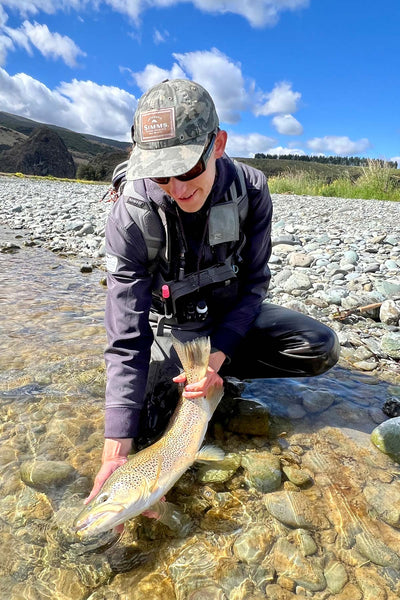
ABOUT OLLIE:
Ollie Bassett is a current New Zealand fly fishing team member and Fly Fishing Instructor


